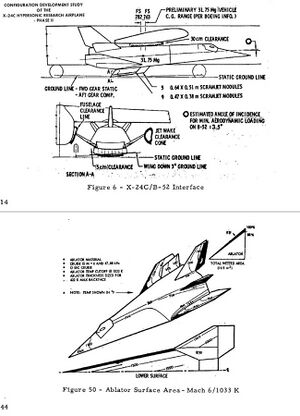Engineering:Lockheed L-301
| L-301 | |
|---|---|

| |
| X-24C configuration images circa January 1977 | |
| Role | Hypersonic research project |
| National origin | United States |
| Manufacturer | Lockheed |
| Status | Cancelled project |
| Number built | None |
Lockheed L-301 (sometimes called the X-24C, though this designation was never officially assigned) was an experimental air-breathing hypersonic aircraft project. It was developed by the NASA and United States Air Force (USAF) organization National Hypersonic Flight Research Facility[1] (NHFRF or NHRF[2]), with Skunk Works as the prime contractor. In January 1977, the program was "tentatively scheduled to operate two vehicles for eight years and to conduct 100 flights per vehicle."[3] NASA discontinued work on L-301 and NHRF in September 1977 due to budget constraints and lack of need.[1]
Development
The L-301 HGV was intended to be a follow-on to the X-15 and X-24 (specifically the X-24B) programs, to take lessons learned from both and integrate them into an airframe capable of at least reaching Mach 8 and engaging in hypersonic skip-glide maneuvers for long range missions. While the NASA program, one of several to use the tentative X-24C designator, was ostensibly canceled in 1977, it was only canceled at the time because of USAF disclosures of duplicate black programs with the same contractors for similar vehicles[citation needed]. The vehicle used both air breathing ram or scramjet propulsion as well as a rocket engine, carrying both RP-1 and LH2 propellant as well as on-board stores of LOX.[citation needed]
Drawings and mission profiles are available from the NASA website.[4]
Design
Propulsion
Originally intended to carry the same XLR-99 engine used by the X-15, the primary engine was changed to the LR-105, which was the sustainer engine used on the Atlas launcher. This rocket engine, burning RP-1 and LOX, was intended to accelerate the X-24C to hypersonic speeds in order to ignite the hydrogen fueled, air breathing ram/scramjet mounted in the belly of the airframe with which it would attain cruise speeds of at least Mach 6 and peak velocities of Mach 8+ at altitudes of 90,000 feet (27,000 m) or more. As such, this vehicle was plainly not intended to reach orbit.[citation needed]
Airframe
Design of the aircraft in various wind tunnel models and contractor drawings seems to follow variations of the FDL-5 and FDL-8 lifting body shapes originally developed by the USAF Flight Dynamics Laboratory in the 1950s, which were used in the earlier X-23 and X-24A/B programs. With a radically swept delta wing, and 2, 3, or 4 vertical stabilizers, as well as several body flaps (depending on the model), the vehicle did not lack for control surfaces. The vehicle measured 74 feet 10 inches (22.81 m) long, 24 ft 2 in (7.37 m) wingspan, and 20 ft 7 in (6.27 m) height.[citation needed]
Various drawings show a payload bay 12 feet (3.7 m) long and perhaps 5 feet (1.5 m) diameter.[5]
References
- ↑ Jump up to: 1.0 1.1 Jenkins, Dennis R. (in en). Lockheed Secret Projects : Inside the Skunk Works. Zenith Imprint. ISBN 978-1-61060-728-5. https://books.google.com/books?id=DUkl5bH6k6EC&dq=National+Hypersonic+Research+Facility+x-15+x-24c&pg=PA98.
- ↑ "Archived copy". http://www.darpa.mil/tto/solicit/BAA08-53/VULCAN_Industry_Day_Presentations.pdf. ["X-24C NHRF"]
- ↑ "Archived copy". https://ntrs.nasa.gov/archive/nasa/casi.ntrs.nasa.gov/19790008668_1979008668.pdf. [CONFIGURATION DEVELOPMENT STUDY OF THE X-24C HYPERSONIC RESEARCH AIRPLANE - PHASE II]
- ↑ NASA.gov[|permanent dead link|dead link}}]
- ↑ NASA.gov[|permanent dead link|dead link}}]
Further reading
- Miller, Jay. The X-Planes: X-1 to X-45. Hinckley, UK: Midland, 2001.
- Rose, Bill, 2008. Secret Projects: Military Space Technology. Hinckley, England: Midland Publishing.
External links
- Operators’ reference drawing [1], [2], [3]
- Encyclopedia Astronautica
- Publicly archived Air Force picture
- Nasa Archives- X-24C Phase 3
 |

